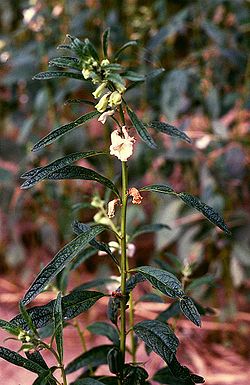Sesamum indicum
| Habit | herbaceous
| |
|---|---|---|
| Height: | ⇕ | 2 ft"ft" can not be assigned to a declared number type with value 2. to 6 ft"ft" can not be assigned to a declared number type with value 6. |
| Width: | ⇔ | 1 ft"ft" can not be assigned to a declared number type with value 1. to 2 ft"ft" can not be assigned to a declared number type with value 2. |
| Lifespan: | ⌛ | annual |
| Exposure: | ☼ | sun |
|---|---|---|
| Water: | ◍ | moist |
| Features: | ✓ | edible |
| USDA Zones: | 10 to 12 | |
| Flower features: | ❀ | red, pink, white |
|
Sesamum > |
indicum > |
Sesame (Sesamum indicum) (Template:PronEng) is a flowering plant in the genus Sesamum. Numerous wild relatives occur in Africa and a smaller number in India. It is widely naturalized in tropical regions around the world and is cultivated for its edible seeds, which grow in pods. The flowers of the sesame seed plant are yellow, though they can vary in colour with some being blue or purple.
It is an annual plant growing to 50 to 100 cm tall, with opposite leaves 4 to 14 cm long with an entire margin; they are broad lanceolate, to 5 cm in 0 broad, at the base of the plant, narrowing to just 1 cm in 1 broad on the flowering stem. The flowers are white to purple, tubular, 3 to 5 cm long, with a four-lobed mouth.
Read about Sesamum indicum in the Standard Cyclopedia of Horticulture
|
|---|
|
Sesamum indicum, Linn. (S. orientale, Linn.). Plant 1-2 ft. high: lvs. variable, 3-5 in. long, oblong or lanceolate, the lower often 3-lobed or parted: corolla pale rose or white, 1 in. long, tubular, 5-cleft, the 2 lobes of the upper lip shorter. July. Tropics. B.M. 1688.—White- and black-seeded varieties have been known for at least two centuries. Runs wild in the extremes. CH
|
Cultivation
It is hardy to zone 10 and is frost tender. It is in flower in July. The flowers are hermaphrodite (have both male and female organs)
The plant prefers light (sandy), medium (loamy) and heavy (clay) soils and requires well-drained soil. The plant prefers acid, neutral and basic (alkaline) soils. It cannot grow in the shade. It requires moist soil.
Requires a well-drained porous soil and a warm sunny sheltered position[1, 238]. Sesame has been cultivated for its edible seed for over 5,000 years and is still widely grown in tropical and warm temperate zones[238]. There are many named varieties[183]. The British climate is probably too cool in the summer to successfully grow this crop, though some people have reported success[206]. An early sowing in the greenhouse and some protection when first planting it out will help. Sesame grows well with sweet corn but it grows badly with sorghum[201].
Propagation
Seed - sow early spring in a greenhouse. Prick out the seedlings into individual pots when they are large enough to handle and plant them out after the last expected frosts. Give them the protection of a cloche until they are growing away well[K]. In warm temperate zones, where frosts are very rare and light, or non-existent, the seed can be sown in situ in the spring or the autumn[238].
Pests and diseases
Varieties
- '90 Day' - A fast-maturing cultivar, it will probably have a better chance of maturing a crop in Britain than the species[K]. It has been developed at the University of California[183].
Gallery
References
- Standard Cyclopedia of Horticulture, by L. H. Bailey, MacMillan Co., 1963
External links
- w:Sesamum indicum. Some of the material on this page may be from Wikipedia, under the Creative Commons license.
- Sesamum indicum QR Code (Size 50, 100, 200, 500)


